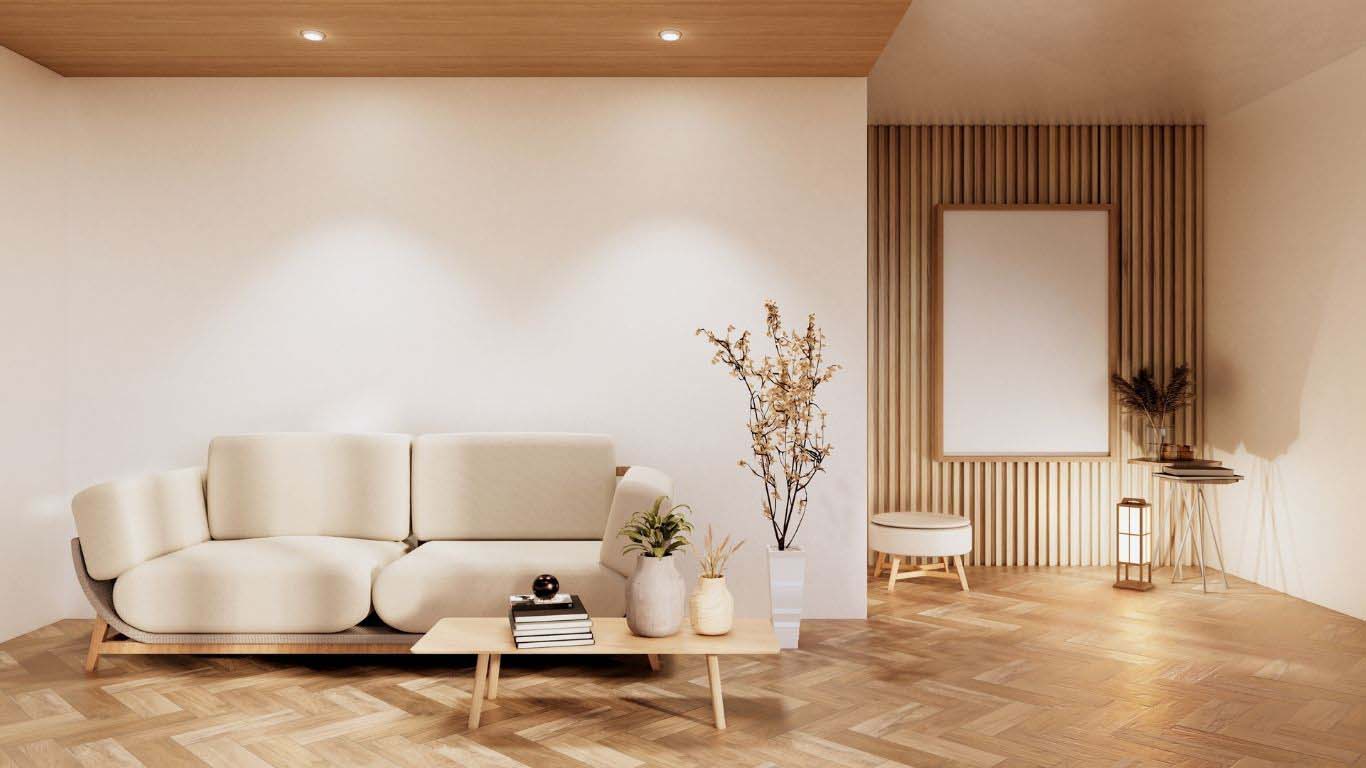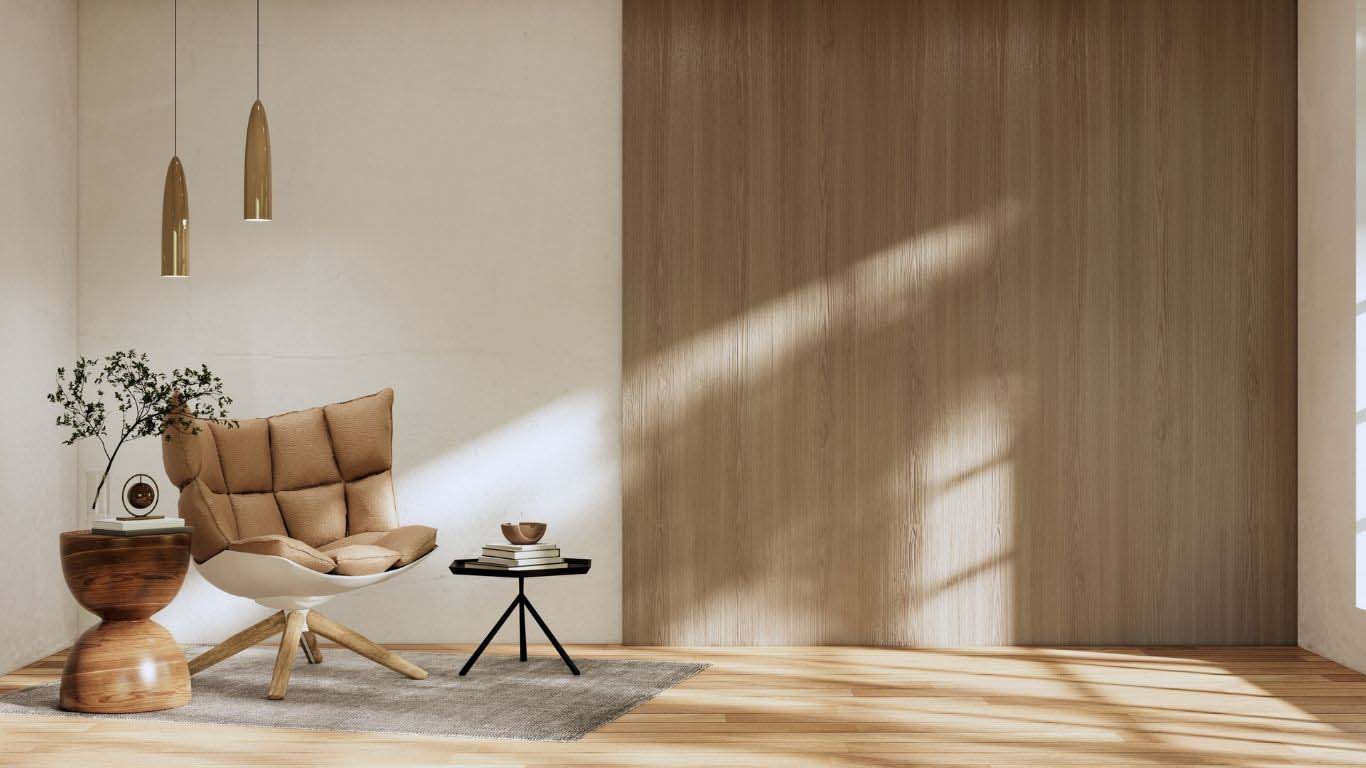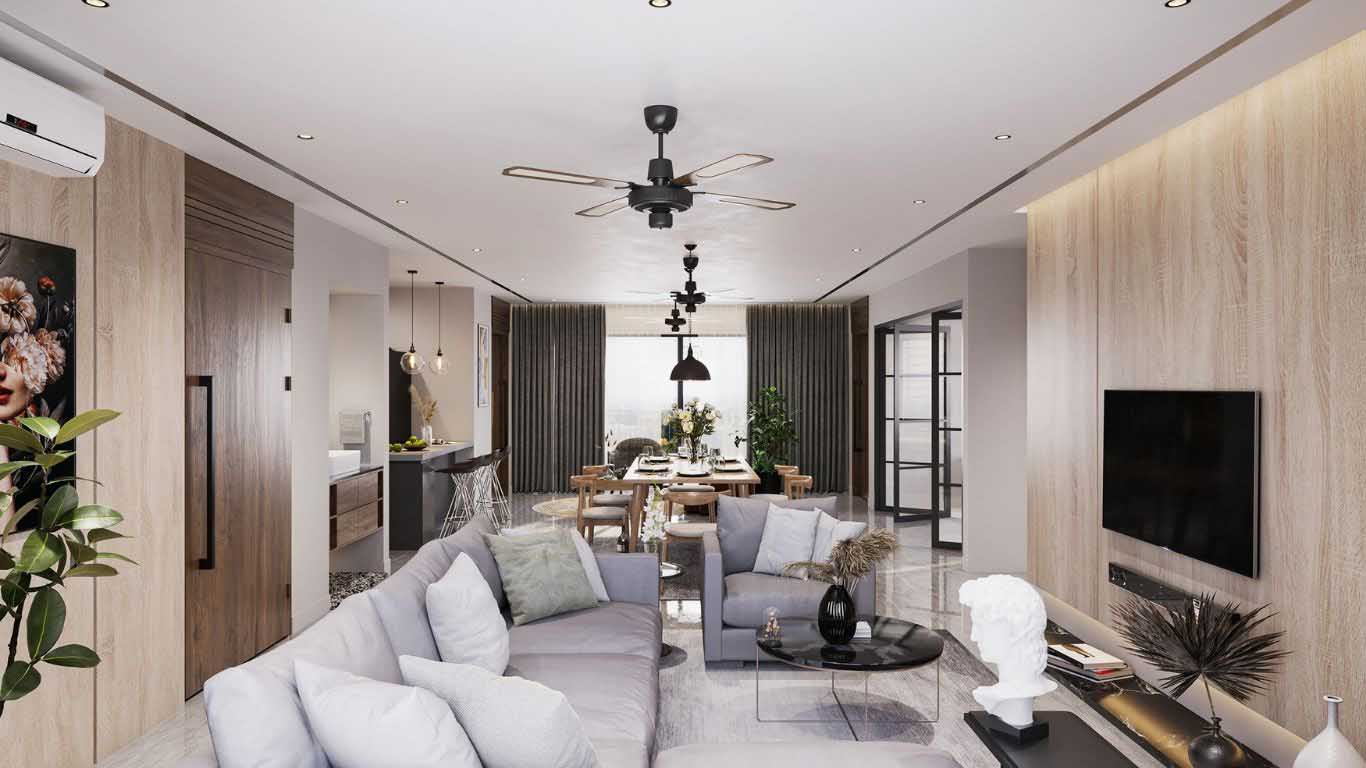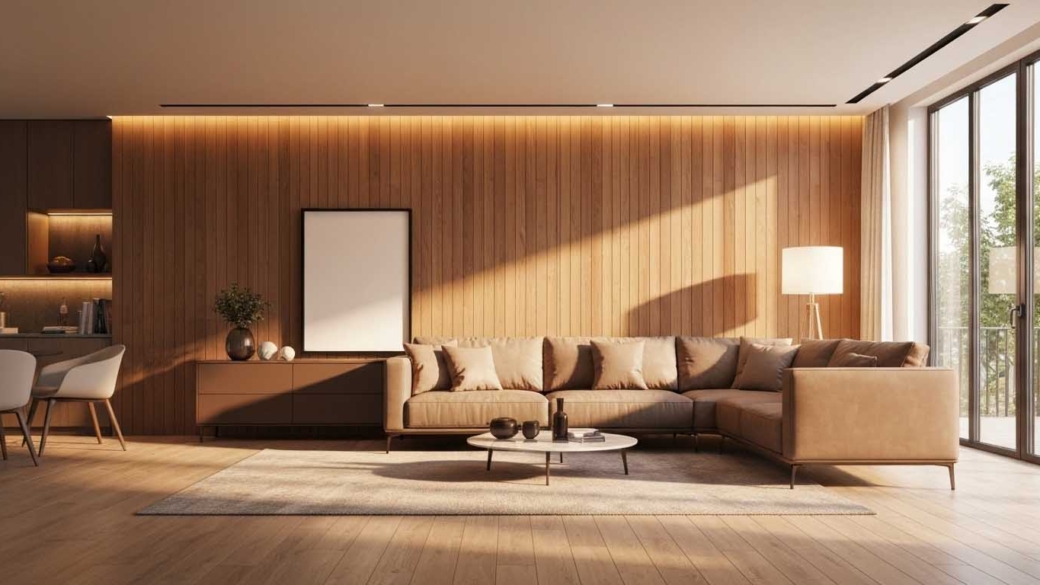Key Highlights
- Modern wood paneling offers diverse styles, from sleek vertical slats and classic shiplap to bold 3D geometric designs for any interior design.
- Popular types of wood for wall panels include durable hardwoods like Oak and Spotted Gum, alongside sustainable reclaimed wood options.
- Customization is key, with finishes like paints and stains allowing you to match your paneling to your unique aesthetic preferences.
- Proper installation, including acclimating the wood, is crucial for the longevity and durability of your new walls.
- Interior wood paneling for walls can improve sound insulation and add significant value to interior spaces.
- Maintenance is simple, usually requiring only regular dusting to keep your panels looking fresh for years.
Introduction
Gone are the days when wood paneling was associated with dated basements. Today, this classic design element is making a major comeback, transforming modern homes with texture, warmth, and sophistication. From accent walls to full-room installations, contemporary interior wood paneling for walls offers a versatile way to express your style. At Panneli, we believe walls are a canvas for your identity, and modern wood panels provide the perfect medium to make a dynamic visual statement in your interior design.
Rethinking Interior Wood Paneling for Walls: Modern Inspiration from Panneli
At Panneli, we see walls as more than just structural elements; they are opportunities for expression and transformation. We specialize in high-quality, customizable wall panels that redefine interiors, turning blank canvases into extraordinary features that reflect your vision.
Our approach to interior wood paneling for walls blends modern aesthetics with practical solutions. Whether you desire a sleek, contemporary look or a bold architectural feature, our panels are crafted with precision and style to match your aesthetic preferences and elevate your space.
Why Interior Wood Paneling for Walls is Making a Comeback
The resurgence of interior wood paneling for walls is due to its timeless appeal and incredible versatility. Wood brings a sense of natural beauty and warmth into a home that few other materials can replicate. It connects interior spaces with the outdoors, creating a calming and inviting atmosphere that aligns with modern biophilic design principles.
Unlike fleeting trends, the character of wood endures. Modern styles like vertical slats, classic shiplap, and intricate geometric patterns have given designers and homeowners new tools to play with. These options move beyond the flat, monotonous look of the past, offering texture, depth, and a focal point for any room. This adaptability makes wood paneling a perfect fit for a wide range of aesthetic preferences, from minimalist to rustic.
Ultimately, interior wood paneling for walls allows you to add a layer of personality to your home. It’s a design choice that feels both luxurious and grounded, offering a durable and visually stunning solution that enhances the character of your living environment.
The Role of Customization in Contemporary Wall Design
Customization is at the heart of modern interior design, and wood wall paneling is no exception. Companies like Panneli specialize in creating tailor-made paneling solutions that perfectly reflect your vision and match your home’s unique aesthetic. This goes far beyond simply choosing a type of wood; it’s about creating a feature that is truly your own.
One of the most powerful tools for customization is the ability to paint or stain your panels. A coat of paint can give interior wood paneling for walls a bold, contemporary look, while a carefully chosen stain can enhance the wood’s natural grain and color. This flexibility allows the paneling to seamlessly integrate into any color scheme, satisfying your specific aesthetic preferences.
Panneli works closely with clients to ensure every detail is perfect, from the initial design concept to the final installation. This commitment guarantees a precise fit and a finish that elevates your space, proving that with customization, your walls can become a centerpiece of transformation.
Exploring the Best Types of Wood for Interior Wall Paneling

Choosing the right type of wood is a critical step in your wood paneling project. The species you select will influence the look, feel, durability, and cost of your walls. Different types of wood offer unique grain patterns, colors, and hardness levels, making each one suitable for different applications and design goals.
Whether you’re drawn to the uniform grain of maple or the rich tones of jarrah, understanding the qualities of each popular choice will help you make an informed decision. Let’s look at some of the best options for interior wood paneling for walls.
Popular Wood Choices and Their Unique Qualities
When selecting from the many types of wood available, it’s important to consider both aesthetics and performance. Hardwoods like Oak and Spotted Gum are celebrated for their exceptional strength and durability, making them an excellent choice for high-traffic areas. Their distinct grain patterns add character and elegance to any room.
Other woods offer unique visual appeal. For example, American Oak provides a classic, golden hue, while Burnt Ash delivers a dramatic, charred look perfect for a modern statement wall. The right wood can define the entire mood of your space, from warm and inviting to sleek and sophisticated.
To help you decide, here’s a quick comparison of some popular options for interior wood paneling for walls:
Wood Type | Key Qualities |
American Oak | Light golden hue, strong grain pattern, classic elegance, and exceptional durability. |
Spotted Gum | Varied color palette from soft creams to rich browns, highly durable, and resilient. |
Blackbutt | Cream to pale brown tones, attractive grain, and naturally resistant to fire and pests. |
Jarrah | Vibrant deep reds and browns, luxurious feel, and naturally resistant to decay. |
Is Plywood a Good Option for Interior Wood Paneling for Walls?
While plywood is often considered for DIY projects due to its affordability and availability, it presents a different set of considerations compared to high-quality wall panels. As a manufactured wood product, plywood can be a versatile option and is easy to cut and install. It can be painted or stained to achieve various looks, making it a flexible choice for budget-conscious updates.
However, it’s important to weigh affordability against long-term performance. Standard plywood may lack the refined finish and durability of solid wood or specialized wood-effect panels. It can be more susceptible to moisture damage and may not offer the same level of acoustic or thermal insulation.
Ultimately, while plywood can be used for interior wood paneling for walls, premium products crafted from sustainable, high-quality materials often provide greater longevity, a more sophisticated aesthetic, and superior performance. For a truly transformative and lasting result, exploring dedicated wall panels is usually the better investment.
10 Modern Wood Paneling Styles Trending in the United States

Modern wood paneling has moved far beyond the simple, flat sheets of the past. Today, there are various styles to suit any taste, transforming walls into dynamic architectural features. These contemporary designs use texture, pattern, and dimension to create stunning visual interest in a range of interior applications.
Whether you prefer clean lines, rustic charm, or intricate designs, there is a popular choice for you. Let’s explore a few of the top trending styles for interior wood paneling for walls that are capturing the attention of designers and homeowners across the country.
Vertical Slat Paneling for Sleek Minimalism
Vertical slat paneling is a hallmark of modern style, prized for its clean lines and minimalist appeal. This design features thin wooden battens, or slats, installed vertically with small gaps in between, creating a sense of height and understated rhythm in a room. The effect is both visually striking and elegantly simple, making it a favorite for contemporary interior spaces.
This style works exceptionally well with woods that have a straight grain or smooth grain, as it emphasizes the linear pattern. The repetition of the slats adds texture and depth without overwhelming the space. It’s a perfect way to create a feature wall in a living room, bedroom, or entryway, adding a touch of elegance and architectural interest.
Often used behind a TV or headboard, vertical slat paneling doubles as a subtle acoustic diffuser, helping to soften sound. Its ability to blend sophistication with simplicity makes it a top choice for anyone looking to incorporate interior wood paneling for walls with a refined and modern feel.
Shiplap: Classic Meets Modern
Thanks to its popularization in modern farmhouse design, shiplap has secured its place as a beloved style for interior wood paneling for walls. Characterized by its overlapping rabbet joints, each wood plank fits snugly together while leaving a subtle horizontal line. This detail gives shiplap its distinct, charming look that bridges the gap between classic and contemporary aesthetics.
While it’s often associated with rustic interiors, shiplap is surprisingly versatile. Painted a crisp white, it creates a bright, clean backdrop for coastal or minimalist decor. Left in a natural wood finish or stained, it can add warmth and texture to traditional or industrial interior spaces. Its timeless appeal lies in this adaptability.
Whether used on an accent wall, a ceiling, or throughout an entire room, shiplap adds character and a sense of history. It proves that a simple wood plank design can be elevated to create a stylish and welcoming environment, making it a go-to choice for many homeowners.
Geometric Patterns and 3D Designs
For those looking to make a bold statement, geometric paneling and 3D designs offer an exciting frontier in interior wood paneling for walls. This modern style moves beyond flat surfaces, using angled cuts, varying thicknesses, and intricate shapes to create a unique texture and dynamic visual effects. From herringbone patterns to complex mosaics, the possibilities are virtually endless.
These designs turn a wall into a work of art. The interplay of light and shadow across the 3D designs adds depth and movement, making the wall a captivating focal point in any room. This style is particularly effective in entryways, dining rooms, or commercial spaces where you want to make a strong first impression.
Thanks to advanced manufacturing and custom millwork, creating these complex patterns is more accessible than ever. For innovative interior applications, this type of interior wood paneling for walls allows for ultimate creativity, bringing a fusion of luxury and artistic expression to contemporary interiors.
Practical Considerations for Installing Interior Wood Paneling for Walls

Proper installation is essential to ensure your interior wood paneling for walls looks great and lasts for years. Before you begin, it’s important to consider factors like the condition of your interior walls, potential exposure to moisture, and the specific requirements of the wood you’ve chosen.
Planning ahead can significantly reduce installation time and prevent common issues like warping or gapping. Taking the right steps from the start will guarantee the beauty and durability of your new paneling, so your investment stands the test of time.
Installation Basics and Pro Tips
A successful installation of interior wood paneling for walls starts long before the first panel is attached. Following a few pro tips can make the process smoother and ensure a professional-looking result. One of the most critical steps is to acclimate the wood. Let your wood panels sit in the room where they will be installed for at least 5-7 days. This allows the wood to adjust to the home’s humidity levels, reducing the risk of expansion or contraction after installation.
When you’re ready to install, ensuring a precise fit is key. Measure your walls carefully and plan your layout before making any cuts. Systems with concealed fixings or tongue-and-groove designs can make achieving a seamless look much easier.
Here are a few more tips for a flawless finish:
- Start with a level line to ensure your first row of paneling is straight, as this will guide the rest of the installation.
- Use a nail gun with finishing nails for a secure hold with minimal visual impact.
- Consider pre-finished panels to save time on painting or staining and to ensure a consistent, durable surface.
The Difference Between Wood Paneling and Wall Cladding
You might hear the terms wood paneling and wall cladding used interchangeably, but there are subtle differences. Wall cladding is a broad term that refers to the application of one material over another to form a new skin or layer on a wall. This can be done for decorative purposes, insulation, or protection and can involve various materials like stone, metal, or vinyl.
Wood paneling is a specific type of interior wall cladding. It refers exclusively to covering walls with wood boards or sheets. Therefore, all wood wall paneling is a form of wall cladding, but not all wall cladding is made of wood.
This distinction is helpful for understanding the scope of different products. While wall cladding is a general category for both interior and exterior applications, interior wood paneling for walls specifically describes the use of wood to enhance the aesthetic and function of indoor spaces.
Enhancing Interiors: Painting, Staining, and Finishing Wood Paneling
One of the greatest advantages of interior wood paneling for walls is the ability to customize it with paint, stain, and various finishes. The right finishing touch can completely transform the look of your wood panels, allowing you to create a custom look that perfectly complements your home’s decor.
Whether you want to highlight the natural grain of the wood with a clear oil or make a bold statement with a vibrant color, these options help you achieve an elegant finish. Let’s explore how you can use paints and stains to personalize your panels.
Creating a Custom Look with Paints and Stains
Absolutely! Painting or staining your interior wood paneling for walls is an excellent way to achieve a truly custom look. The choice between paint and stain depends on your aesthetic preferences and the effect you want to create. Staining is ideal for anyone who wants to enhance the natural beauty of the wood, allowing the grain and texture to shine through.
On the other hand, applying paint offers a more dramatic transformation. It can modernize older paneling or unify a space with a consistent color. A fresh coat of white paint can brighten a room and give it a clean, contemporary feel, while a dark, moody color can create a cozy and sophisticated atmosphere.
Consider these points when deciding on a finish:
- Stain: Enhances the wood’s natural grain and is available in various tones to match your decor.
- Paint: Provides a solid color finish, perfect for a modern or minimalist aesthetic.
- Clear Coats: Protective oils and finishes like Cutek Extreme CD50 can preserve the wood’s natural look while adding durability.
Maintenance Tips to Keep Interior Wood Paneling for Walls Looking Fresh
One of the benefits of interior wood paneling for walls is its low maintenance requirements. With a little care, your panels can look beautiful for decades. The most important task is regular dusting with a soft, dry cloth or a hand brush to prevent dust and grime from building up in the grain or grooves.
For a deeper clean, you can use a slightly damp cloth, but always avoid harsh chemical cleaners that could damage the wood’s finish. Protecting the wood from environmental factors is also key. Finishes that offer protection from UV rays can prevent the wood from fading over time, especially in rooms with a lot of natural light.
To keep your panels in top condition, follow these simple tips:
- Dust weekly to keep the surface clean.
- Wipe up any spills immediately to protect the wood from moisture.
Be mindful of furniture placement to avoid accidental scratches or dents.
Conclusion
In conclusion, interior wood paneling for walls is a versatile design choice that enhances the aesthetic value of any space. With modern takes on this classic element, you can transform your home or business into a stylish haven. From sleek vertical slat designs to the charm of shiplap, the possibilities are endless. Customization plays a vital role in achieving the perfect look tailored to your unique taste, while practical considerations ensure durability and functionality. By exploring various wood types and styles, you can make informed decisions that elevate your interiors. If you’re ready to bring your vision to life, don’t hesitate to get quotes for commercial projects and let Panneli help you create stunning wall designs that reflect your identity.
Frequently Asked Questions (FAQ)
Does Interior Wood Paneling Help With Sound Insulation?
Yes, interior wood paneling for walls can significantly improve sound insulation. The natural density and texture of wood help dampen and absorb sound waves, reducing echo and creating a quieter, more comfortable environment. This makes wall panels an excellent choice for bedrooms, offices, and living rooms where acoustic comfort is desired.
What Are the Pros and Cons of Using Reclaimed Wood on Walls?
The pros of using reclaimed wood are its unmatched character, sustainability, and eco-friendliness, as it reduces your carbon footprint. It adds a unique story to rustic interiors. A potential con is that sourcing can be inconsistent, but reputable suppliers like Centennial Woods provide high-quality, uniform, and insect-free reclaimed wood panels.
How Much Does Interior Wood Wall Paneling Typically Cost?
The cost of interior wood paneling for walls varies widely based on the type of wood and quality. Reclaimed wood products, for instance, can range from $7 to $14 per square foot. While some options offer great affordability, custom and premium hardwoods will be at the higher end of the spectrum.



